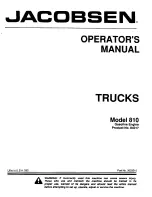
42–03 Air Dryer Inspection
1.
Park the vehicle on a level surface and apply the
parking brakes. Shut down the engine. Chock
the tires.
2.
Check for moisture in the air brake system by
opening the reservoir drain cocks. Examine the
discharge. Some trace of water in the discharge
is normal. A discharge of a milky gray liquid indi-
cates excessive moisture is present in the air
system and the desiccant cartridge needs to be
replaced. See
Group 42
of the
Columbia® Work-
shop Manual
for troubleshooting procedures. The
following conditions could cause small amounts
of moisture to be found in the air system:
•
An outside air source has been used to
charge the air brake system. This air did
not pass through the drying bed.
•
Air usage is unusually high and not normal.
This may be due to accessory air demands
or some unusual air requirement that does
not allow the compressor to load and un-
load in a normal fashion. Check for air sys-
tem leaks.
•
The air dryer has been installed on a sys-
tem that had previously been operated
without an air dryer. This type of system
will be saturated with moisture, and several
weeks of operation may be needed to fully
dry the system.
•
The temperature range in your area fluctu-
ates more than 30 degrees in one day.
Small amounts of water can accumulate in
the air brake system due to condensation.
Under these conditions, the presence of
moisture is normal and should not be con-
sidered an indication of poor air dryer per-
formance.
3.
Inspect the air dryer for external damage, and
check that the unit is tightly mounted on the
frame. If the air dryer mounting is loose, See
Group 42
of the
Columbia® Workshop Manual
for mounting instructions.
4.
Turn on the ignition switch, but do not start the
engine.
5.
Disconnect the harness connector from the air
dryer.
6.
Connect a voltmeter to circuit 94 on the air dry-
er’s harness connector and to a body ground
point. Check for battery voltage. If voltage is not
found, check and repair the open or short to
ground in wire 94.
7.
Connect a voltmeter between the two terminals
on the air dryer’s harness connector. If voltage is
not found, repair the open in the ground circuit
wiring.
8.
Use an ohmmeter to check resistance between
the terminals on the end cover. See
. The
end cover contains the heater/thermostat. If the
heater/thermostat is between 40 and 90°F (5 and
32°C), the heater/thermostat measured resis-
tance will be infinite ohms. If the measured resis-
tance is less than infinity, replace the
heater/thermostat.
9.
Remove the heater/thermostat assembly and
place it in a freezer for about five minutes to cool
it below 40°F (5°C). Remove the cold
heater/thermostat assembly and check resis-
tance between the heater/thermostat terminals.
Resistance should be 1.5 to 3.0 ohms. As the
temperature of the heater/thermostat assembly
increases, the ohm reading will increase. When
the temperature goes above 45°F (7°C) mea-
f421292
10/07/2016
1
2
3
1.
Seal
2.
O-Ring
3.
Air Dryer Base
Fig. 4, Desiccant Cartridge Replacement
Brakes
42
Columbia Maintenance Manual, September 2015
42/5
Summary of Contents for CL112 2015
Page 2: ......
Page 4: ......
Page 10: ......
Page 32: ......
Page 34: ......
Page 38: ......
Page 40: ......
Page 42: ......
Page 44: ......
Page 46: ......
Page 48: ......
Page 50: ......
Page 52: ......
Page 60: ......
Page 62: ......
Page 66: ......
Page 68: ......
Page 74: ......
Page 86: ......
Page 94: ......
Page 96: ......
Page 104: ......
Page 106: ......
Page 116: ......
Page 118: ......
Page 120: ......
Page 122: ......
Page 128: ......
Page 140: ......
Page 142: ......
Page 152: ......
Page 156: ......
Page 164: ......
Page 166: ......
Page 168: ......
Page 172: ......
Page 176: ......
Page 178: ......
Page 180: ......







































